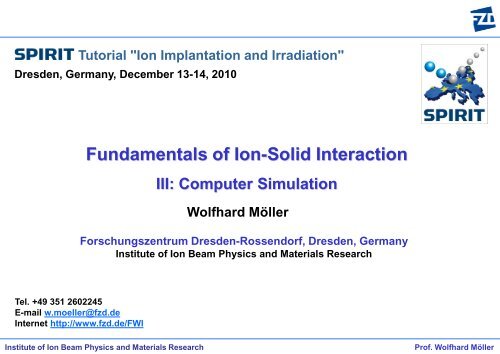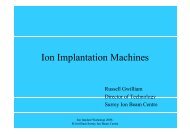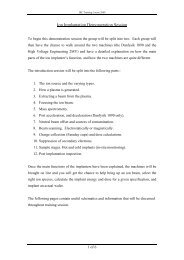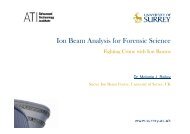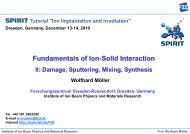Tutorial "Ion Implantation and Irradiation" - SPIRIT
Tutorial "Ion Implantation and Irradiation" - SPIRIT
Tutorial "Ion Implantation and Irradiation" - SPIRIT
Create successful ePaper yourself
Turn your PDF publications into a flip-book with our unique Google optimized e-Paper software.
<strong>Tutorial</strong> "<strong>Ion</strong> <strong>Implantation</strong> <strong>and</strong> Irradiation"<br />
Dresden, Germany, December 13-14, 2010<br />
Tel. +49 351 2602245<br />
E-mail w.moeller@fzd.de<br />
Internet http://www.fzd.de/FWI<br />
Fundamentals of <strong>Ion</strong>-Solid Interaction<br />
III: Computer Simulation<br />
Wolfhard Möller<br />
Forschungszentrum Dresden-Rossendorf, Dresden, Germany<br />
Institute of <strong>Ion</strong> Beam Physics <strong>and</strong> Materials Research<br />
Institute of <strong>Ion</strong> Beam Physics <strong>and</strong> Materials Research Prof. Wolfhard Möller
Computer Simulation of <strong>Ion</strong>-Solid Interaction<br />
V(R)<br />
Binary Collision<br />
Approximation<br />
(BCA)<br />
R<br />
Classical Molecular<br />
Dynamics (MD)<br />
V(R)<br />
Lattice Kinetic<br />
Monte Carlo (KMC)<br />
Institute of <strong>Ion</strong> Beam Physics <strong>and</strong> Materials Research Prof. Wolfhard Möller<br />
R<br />
E<br />
Coord. #<br />
T = 0, t < 10 -13 s T > 0, t < 10 -9 s T > 0, 10 -13 s < t < ∞
TRIM BCA Computer Simulation<br />
Trajectories of incident ions <strong>and</strong> all<br />
recoil atoms as sequence of binary<br />
collisions (BCA = Binary Collision<br />
Approximation)<br />
“Linear” cascade regime: Only<br />
collisions with target atoms at rest<br />
Validity: above E 10..30 eV<br />
(“Collisional phase” of the<br />
cascade)<br />
Collisional Transformation<br />
E E Tn<br />
nSes<br />
<br />
r r s<br />
, <br />
Tr<br />
, <br />
, <br />
TRIM = TRansport of <strong>Ion</strong>s in Matter<br />
S e Electronic Stopping<br />
Cross Section<br />
n Atomic Density<br />
T n Nuclear Energy Loss<br />
(from )<br />
Tr Angular Transformation<br />
Institute of <strong>Ion</strong> Beam Physics <strong>and</strong> Materials Research Prof. Wolfhard Möller<br />
E<br />
r<br />
,<br />
s<br />
,<br />
“State” of moving atom<br />
Energy E<br />
Coordinates r<br />
Flight Direction ,<br />
Collisional Variables<br />
Free Pathlength s<br />
Polar Deflection <br />
Azimuthal Deflection <br />
Energy Loss E el
TRIM BCA Computer Simulation<br />
Amorphous Substance<br />
Position of target atoms <strong>and</strong><br />
thereby impact parameter are<br />
r<strong>and</strong>omly chosen<br />
Path is r<strong>and</strong>om<br />
R<strong>and</strong>om Generator r 0<br />
, 1<br />
p <br />
Impact Parameter p<br />
Azimuthal Angle<br />
p<br />
max r<br />
2r<br />
Conservation of atomic density,<br />
one collision per target atom<br />
Constant free pathlength<br />
equal to mean atomic distance<br />
<br />
<br />
Fast algorithm for classical scattering<br />
integral (p) (“Magic Formula”)<br />
Multiatomic target materials<br />
Static target: No modification<br />
s<br />
p<br />
Institute of <strong>Ion</strong> Beam Physics <strong>and</strong> Materials Research Prof. Wolfhard Möller<br />
p<br />
2<br />
max<br />
<br />
n<br />
s<br />
<br />
1<br />
/<br />
3<br />
n<br />
1<br />
<br />
p<br />
p max<br />
Biersack <strong>and</strong> Haggmark<br />
1978<br />
Eckstein <strong>and</strong> Biersack<br />
1982 (Sputter Version)<br />
Ziegler ~1980 ... 2010<br />
http://www.srim.org<br />
s
TRIM BCA Computer Simulation<br />
Classical Scattering Integral (CMS System)<br />
2 p<br />
V ( R ) <br />
R<br />
1<br />
min<br />
<br />
0<br />
1<br />
d<br />
R<br />
V<br />
1 <br />
E<br />
2<br />
Z1Z<br />
2e<br />
<br />
<br />
4<br />
R <br />
0<br />
<br />
<br />
<br />
R c<br />
<br />
R <br />
<br />
a <br />
p<br />
R<br />
Screened Coulomb Potential<br />
Asymptotic Path Approximation<br />
Approximate Time Integral<br />
(Hard Sphere Approximation)<br />
<br />
t p tan R 0<br />
2<br />
t<br />
2<br />
2<br />
0 10 20 30<br />
x = R/a<br />
Institute of <strong>Ion</strong> Beam Physics <strong>and</strong> Materials Research Prof. Wolfhard Möller<br />
1<br />
f U(x)<br />
10 -2<br />
10 -4<br />
p<br />
Bohr<br />
R<br />
t<br />
<br />
t R<br />
HFS atomic calculations with<br />
linear superposition of atomic<br />
electron densities for 522<br />
projectile-target<br />
combinations<br />
“Universal”<br />
Fit<br />
Function<br />
R<br />
Thomas-Fermi
TRIM Energy Parameters<br />
Sputtering<br />
BCA Parameters<br />
Radiation<br />
Damage<br />
<strong>Ion</strong><br />
Slowing<br />
Down<br />
Cutoff energy at which particle histories<br />
are terminated (~ 3 eV)<br />
Institute of <strong>Ion</strong> Beam Physics <strong>and</strong> Materials Research Prof. Wolfhard Möller<br />
Eco<br />
Bulk binding energy subtracted from<br />
nuclear energy transfer (often set to 0) Eb<br />
Surface binding energy for sputtering<br />
(enthalpy of sublimation for monoatomic<br />
materials: 2...8 eV; from thermodynamic<br />
data for multicomponent materials)<br />
Threshold energy of Frenkel pair<br />
formation for damage calculation<br />
(25...80 eV)<br />
Electronic stopping model (nonlocal,<br />
local) <strong>and</strong> data<br />
Es<br />
Ed<br />
Se
TRIM: <strong>Ion</strong> Trajectories<br />
<strong>Ion</strong>s only<br />
<strong>Ion</strong>s <strong>and</strong> recoil atoms<br />
4 ions<br />
100 ions<br />
Institute of <strong>Ion</strong> Beam Physics <strong>and</strong> Materials Research Prof. Wolfhard Möller
TRIM: Range, Energy Deposition, Damage Profiles<br />
Projected Range<br />
Distribution (nm-1 )<br />
Vacancy Distribution (nm -1 )<br />
0.2 1 keV<br />
Ar + Si<br />
0<br />
5<br />
0<br />
0<br />
Depth (nm)<br />
10<br />
0 10<br />
Depth (nm)<br />
Institute of <strong>Ion</strong> Beam Physics <strong>and</strong> Materials Research Prof. Wolfhard Möller<br />
Energy Deposition (eV/nm)<br />
200<br />
0<br />
50<br />
0<br />
nuclear<br />
electronic
TRIM Results: Doping Profiles<br />
Institute of <strong>Ion</strong> Beam Physics <strong>and</strong> Materials Research Prof. Wolfhard Möller
TRIDYN – Including Dynamic Alteration<br />
Collision cascade simulation as in TRIM<br />
Initially equidistant depth slabs<br />
(i=1,...,N) with thickness x 0 <strong>and</strong><br />
fractional compositions c ik (k=1,...,M)<br />
for M different elements (including<br />
projectile)<br />
Each pseudoparticle (deposited,<br />
relocated or sputtered atom) in the<br />
computer simulation corresponds to<br />
an increment in areal density<br />
<br />
<br />
<br />
N<br />
tot<br />
pp<br />
tot Total <strong>Ion</strong> Fluence<br />
N pp Total Number of<br />
Pseudoprojectiles<br />
Only compositional information is<br />
provided. BCA is unable to treat<br />
sructure or morphology.<br />
For each incident pseudoprojectile,<br />
simulation in two steps:<br />
Slowing down <strong>and</strong> cascade formation,<br />
implantation, sputtering <strong>and</strong><br />
relocation<br />
Relaxation of depth intervals<br />
according to fixed atomic volumes<br />
Möller, Eckstein <strong>and</strong> Biersack 1984<br />
Institute of <strong>Ion</strong> Beam Physics <strong>and</strong> Materials Research Prof. Wolfhard Möller
TRIDYN Dynamic Relaxation<br />
After termination of pseudoprojectile <strong>and</strong> recoil<br />
histories, new areal densities ik are calculated<br />
all components <strong>and</strong> depth intervals. From these<br />
Fractional<br />
Compositions<br />
Total<br />
Atomic<br />
Densities<br />
Slab<br />
Thicknesses<br />
Limitation<br />
of Slab<br />
Thicknesses<br />
cik<br />
1<br />
n<br />
tot<br />
i<br />
x<br />
0.<br />
5<br />
i<br />
<br />
ik<br />
<br />
j<br />
<br />
j<br />
<br />
1<br />
n<br />
tot<br />
i<br />
ij<br />
c<br />
n<br />
ij<br />
0<br />
j<br />
<br />
j<br />
n j 0 Pure Element<br />
Atomic Densities<br />
ij<br />
xi<br />
1.<br />
5<br />
x<br />
Otherwise Splitting<br />
or Combination<br />
0<br />
For reasonable statistics<br />
<strong>and</strong> precision, the relative<br />
change per slab has to be<br />
kept sufficiently small, by<br />
choosing Δν small enough.<br />
From experience,<br />
0.<br />
05<br />
Institute of <strong>Ion</strong> Beam Physics <strong>and</strong> Materials Research Prof. Wolfhard Möller<br />
max<br />
i<br />
<br />
i<br />
<br />
<br />
<br />
<br />
i <br />
<br />
per pseudoprojectile
TRIDYN - Artificial Add-ons<br />
Local Saturation<br />
e.g., stoichiometric limitation<br />
Feeding excess into vacuum ("reemission")<br />
or to flanks of profile ("diffusion")<br />
Molecular Release<br />
e.g., by local saturation or by bond breaking<br />
Release<br />
R <br />
2<br />
fc<br />
c concentration of<br />
excess or free atoms<br />
Matrix Effects in Sputtering: Simple Model<br />
Sputter yield of a specified component depends<br />
linearly on surface concentration of another<br />
component<br />
Molecular Sputtering: Simple Model<br />
Diatomic "molecular" yield is assumed to be<br />
proportional to product of monomer yields<br />
Y <br />
Institute of <strong>Ion</strong> Beam Physics <strong>and</strong> Materials Research Prof. Wolfhard Möller<br />
Implant Concentration<br />
M<br />
i<br />
f<br />
i<br />
M<br />
, j<br />
c<br />
s,<br />
j<br />
f predefined factor<br />
Y <br />
mol<br />
i,<br />
j<br />
f<br />
f Predefined<br />
Factor<br />
Depth<br />
mol<br />
i,<br />
j<br />
YY<br />
i<br />
j<br />
C max
TRIDYN Applications<br />
Implant Concentration<br />
Partial Sputtering Yields<br />
High-Fluence <strong>Implantation</strong><br />
Fluence<br />
Depth<br />
Preferential Sputtering<br />
A<br />
B<br />
Time or Fluence<br />
A xB y<br />
<strong>Ion</strong> Mixing<br />
A B<br />
Depth<br />
Institute of <strong>Ion</strong> Beam Physics <strong>and</strong> Materials Research Prof. Wolfhard Möller<br />
Atomic Fractions<br />
Atomic Fractions<br />
<strong>Ion</strong>-Assisted Deposition<br />
B<br />
A<br />
Depth<br />
A o<br />
B +<br />
A B<br />
C<br />
C
TRIDYN Applications<br />
<strong>Ion</strong>-Beam Assisted Deposition<br />
of Boron Nitride<br />
0<br />
0 0.4 0.8 1.2 1.6 20<br />
Institute of <strong>Ion</strong> Beam Physics <strong>and</strong> Materials Research Prof. Wolfhard Möller<br />
N/B Bulk Ratio<br />
3.0<br />
2.4<br />
1.8<br />
1.2<br />
0.6<br />
500 eV N +<br />
N +<br />
Expt.<br />
w/o<br />
N/B Flux Ratio<br />
Ag<br />
TRIDYN<br />
with<br />
molecular<br />
reemissio<br />
n<br />
W. Möller <strong>and</strong> D. Bouchier, SCT 45(1991)73<br />
B
TRIDYN Applications<br />
Target Poisoning during<br />
Reactive Magnetron Sputtering<br />
<strong>Ion</strong> (Ar + ,N 2 + ,N + ) <strong>and</strong> radical (N 0 ) fluxes<br />
from simple 0D plasma model<br />
Sticking 0<br />
N 2 addition (mol%)<br />
TRIDYN<br />
Ar+N 2<br />
→ Ti<br />
Sticking 1<br />
W. Möller <strong>and</strong> D. Güttler, JAP 45(2007)094501<br />
Institute of <strong>Ion</strong> Beam Physics <strong>and</strong> Materials Research Prof. Wolfhard Möller
3D Lattice Kinetic Monte Carlo Simulation<br />
Precipitate<br />
Detachment<br />
Monomer<br />
Attachment<br />
Diffusion<br />
Empty<br />
Site<br />
"Ising" Model: Configurational energy<br />
of each atom depends only on<br />
occupied<br />
number of<br />
lattice<br />
nearest<br />
site<br />
neighbours<br />
selected Probability for of jump attempt from<br />
initial site i to final site f<br />
empty lattice site<br />
diffusion jump<br />
detachment jump<br />
attachment 0 jump<br />
{<br />
1 if Ni<br />
N f<br />
E p<br />
N i N<br />
f <br />
kT e else<br />
Institute of <strong>Ion</strong> Beam Physics <strong>and</strong> Materials Research Prof. Wolfhard Möller<br />
w<br />
Ed Ep Ni,f if<br />
<br />
<br />
0<br />
e<br />
Ed<br />
<br />
kT<br />
Attempt frequency<br />
Activation energy of diffusion<br />
Energy gain per nearest neighbour<br />
Initial <strong>and</strong> final number of nearest<br />
neighbours
Ostwald Ripening by LKMC Simulation<br />
GT Equation Reproduced<br />
Institute of <strong>Ion</strong> Beam Physics <strong>and</strong> Materials Research Prof. Wolfhard Möller
Inverse Ostwald Ripening by LKMC Simulation<br />
Start<br />
Conventional OR Inverse OR<br />
Institute of <strong>Ion</strong> Beam Physics <strong>and</strong> Materials Research Prof. Wolfhard Möller


